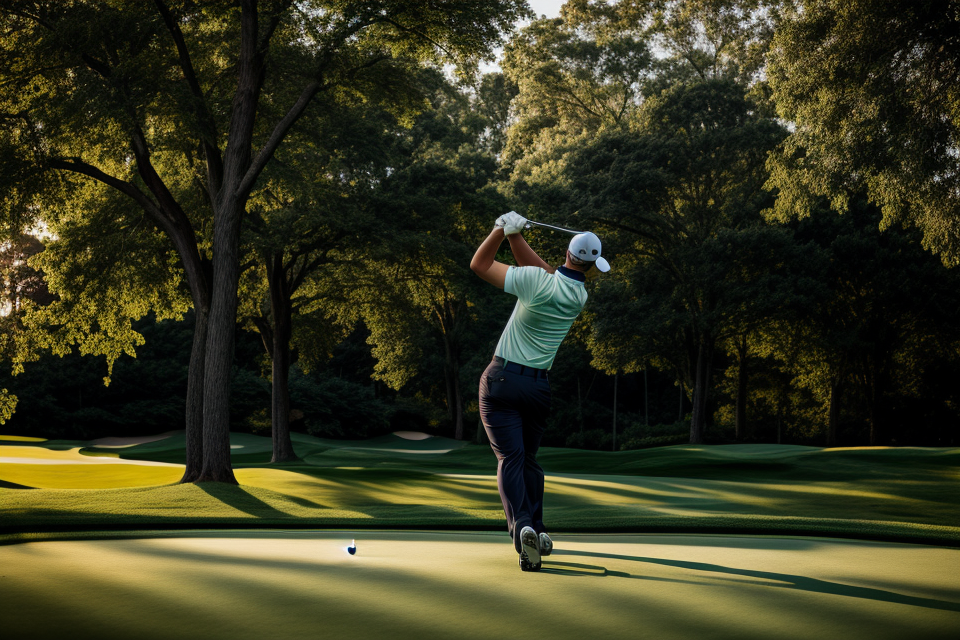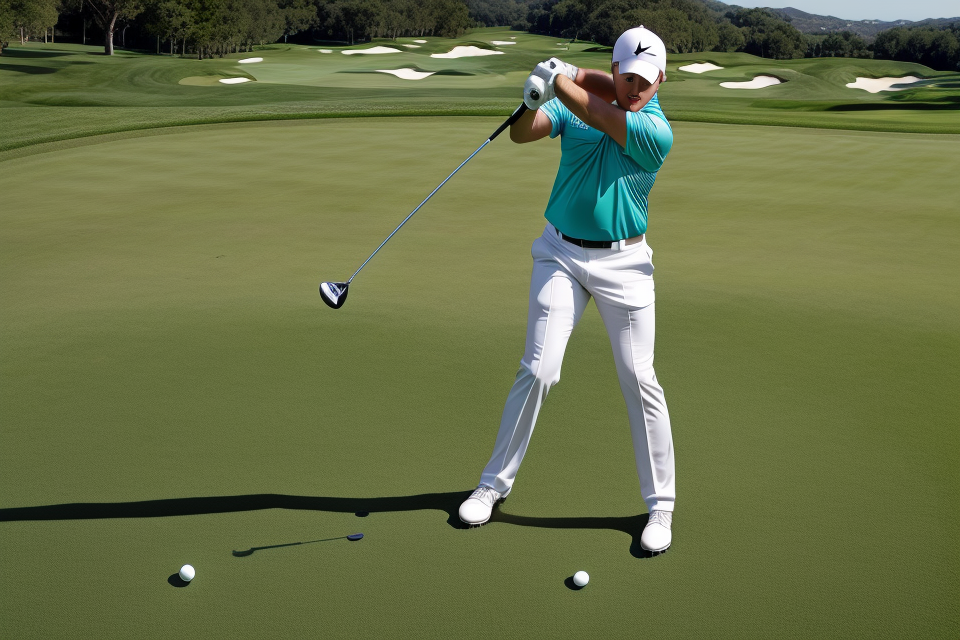
Golf is a game that requires precision, skill, and patience. A crucial aspect of the game is the golf swing, which determines the distance and accuracy of the shot. A perfect golf swing is the goal of every golfer, but achieving it requires practice, dedication, and the right techniques. In this article, we will explore the techniques and drills that can help you master the perfect golf swing. From the grip to the follow-through, we will cover all the essential elements of a successful swing. So, grab your clubs and get ready to improve your game!
Understanding the Basics of a Great Golf Swing
Grip
When it comes to mastering the perfect golf swing, one of the most crucial elements is the grip. The way you hold the golf club can significantly impact your swing and ultimately determine the direction and distance of your shots. In this section, we will delve into the specifics of a great golf grip, including:
The correct grip pressure
The pressure you apply to the golf club during your swing is a crucial factor in maintaining control and accuracy. The ideal grip pressure is often described as “firm but relaxed,” meaning that you should grip the club tightly enough to prevent it from slipping, but not so tightly that your hands become tense or cramped. A good way to determine the right grip pressure is to place your thumbs on the top of the grip and wrap your fingers around the club, ensuring that your palms are facing each other.
How to position your hands on the golf club
In addition to grip pressure, the position of your hands on the golf club is also critical to a successful swing. The most common grip type is the “baseball grip,” in which the bottom of the handle is resting between the middle and ring fingers of your right hand (for right-handed golfers). Your left hand should be placed on the handle just below your right, with your fingers wrapping around the club and resting on top of your right hand.
The importance of a neutral grip
A neutral grip refers to the alignment of your hands in relation to the clubface. To achieve a neutral grip, your hands should be positioned so that the clubface is square to the target line. This means that the tip of the clubface is pointing straight ahead, with neither a hook nor a slice. A neutral grip promotes a straight, powerful swing and can help prevent injuries to the wrists and arms.
By paying close attention to these key aspects of the grip, you can improve your overall swing technique and increase your chances of making accurate, consistent shots.
Stance
When it comes to mastering the perfect golf swing, one of the most crucial elements is your stance. The right stance can help you generate power, maintain balance, and improve your overall performance on the course. Here are some key aspects to consider when it comes to the stance in a great golf swing:
The right stance for a powerful swing
The stance you take before hitting a golf shot is crucial to generating power and accuracy. One of the most important factors to consider is the distance between your feet. Generally, it’s recommended to have your feet about shoulder-width apart, with the inside of your feet facing towards the target. This stance helps to create a stable base from which to swing, while also allowing for a natural turn of the hips and torso during the swing.
The role of your feet, knees, and hips in the stance
In addition to the distance between your feet, the position of your feet, knees, and hips is also important. Your feet should be facing towards the target, with the outside of your feet slightly pointed towards the target line. This helps to create a stable base and allows for a smooth transition from the backswing to the downswing. Your knees should be slightly bent, which helps to maintain flexibility and balance throughout the swing. Your hips should be positioned towards the target, with your weight evenly distributed on both feet.
Maintaining balance during the swing
Maintaining balance is crucial to hitting a powerful and accurate golf shot. Your stance should be such that you are able to maintain your balance throughout the swing, from the backswing to the follow-through. If you lean too far forward or backward, it can disrupt your balance and throw off your swing. It’s important to practice your stance and swing in a way that feels natural and comfortable, while also allowing you to maintain balance and control throughout the shot.
Swing Plane
Understanding the Concept of Swing Plane
The swing plane refers to the path that the club travels during the golf swing. It is the imaginary plane that the clubhead moves along as it approaches and strikes the ball. The swing plane is essential in determining the direction and trajectory of the ball’s flight. Understanding this concept is crucial in developing a consistent and powerful golf swing.
The Relationship between Swing Plane and Ball Flight
The swing plane plays a critical role in determining the ball’s flight. If the club moves along an incorrect swing plane, the ball will not travel in the desired direction, and the distance and accuracy of the shot will suffer. The relationship between the swing plane and ball flight is a crucial factor in determining the success of a golf shot.
How to Adjust Your Swing Plane for Optimal Results
Adjusting the swing plane is a critical aspect of improving one’s golf swing. Here are some tips to help you adjust your swing plane for optimal results:
- Address the ball with your body facing the target line. This will help you maintain a consistent swing plane throughout the shot.
- Keep your arms and hands relaxed, and avoid gripping the club too tightly. This will help you maintain a smooth and consistent swing plane.
- Focus on keeping the clubhead moving along the correct swing plane throughout the entire swing.
- Practice your swing in front of a mirror or with a coach to help you develop a feel for the correct swing plane.
By understanding the concept of swing plane, the relationship between swing plane and ball flight, and how to adjust your swing plane, you can improve your golf swing and achieve optimal results on the course.
The Importance of a Full-Body Swing
Using Your Core
Activating your core muscles is essential for generating power and stability in your golf swing. By engaging your core, you can maintain balance, control your body movements, and transfer energy efficiently from your lower body to your upper body. In this section, we will discuss the role of your core muscles in a powerful swing, how to activate your core during the swing, and common mistakes to avoid when using your core.
- The role of your core muscles in a powerful swing
- Your core muscles, including the rectus abdominis, obliques, erector spinae, and transverse abdominis, play a crucial role in maintaining a stable and balanced position throughout the swing. They help you control your body movements, generate power, and transfer energy from your lower body to your upper body.
- Strong core muscles also enable you to maintain a consistent swing plane and prevent unwanted movements that can negatively affect your shot accuracy and distance.
- How to activate your core during the swing
- Activating your core muscles requires focus and coordination. To engage your core during the swing, follow these steps:
- Set up to the ball with your feet shoulder-width apart, and your knees slightly bent.
- Take a deep breath and exhale as you start your swing.
- Engage your abdominal muscles by drawing your belly button towards your spine.
- Maintain this engagement throughout the swing, particularly during the power phase.
- Practice activating your core muscles in isolation before integrating them into your swing. You can do this by performing exercises such as planks, sit-ups, and Russian twists.
- Activating your core muscles requires focus and coordination. To engage your core during the swing, follow these steps:
- Common mistakes to avoid when using your core
- Many golfers make the mistake of relying too much on their upper body and neglecting their core muscles. This can lead to a lack of power, inconsistent ball striking, and increased risk of injury.
- Another common mistake is not properly engaging the core muscles during the swing. This can result in poor balance, excessive swaying, and a loss of control over your body movements.
- To avoid these mistakes, focus on maintaining proper posture, using your legs and hips to generate power, and activating your core muscles at the appropriate times during the swing. With practice and patience, you can develop a full-body swing that maximizes your performance on the golf course.
Arms and Shoulders
In order to achieve a powerful and accurate golf swing, it is crucial to understand the role of your arms and shoulders. Your arms and shoulders work together to deliver the clubhead to the ball, and a proper understanding of their role can help you improve your swing.
- The correct role of your arms and shoulders in the swing
Your arms and shoulders should work in unison to deliver the clubhead to the ball. Your arms should act as extensions of your shoulders, and your shoulders should rotate to create power and accuracy. Your arms should also remain relaxed throughout the swing to prevent tension and improve control. - The importance of keeping your arms relaxed
A tense grip or tensing of the arms during the swing can lead to a loss of power and accuracy. To keep your arms relaxed, it is important to practice good posture and alignment, and to use a comfortable grip on the club. It is also important to avoid tensing up your shoulders and arms during the swing. - How to avoid common mistakes with your arms and shoulders
Some common mistakes to avoid with your arms and shoulders include overusing your arms, tensing up your shoulders, and using an incorrect grip. It is also important to avoid using your arms to compensate for poor posture or alignment. To improve your swing, focus on using your shoulders and arms in unison, keeping your arms relaxed, and avoiding common mistakes.
Legs and Hips
The role of your legs and hips in a powerful swing
In a full-body golf swing, your legs and hips play a crucial role in generating power and maintaining balance. They work together to provide a stable base and to transfer energy from your lower body to your upper body, enabling you to hit the ball with precision and distance. Your legs and hips are essential components of a smooth and efficient swing, and mastering their movements can greatly improve your overall performance on the golf course.
How to engage your legs and hips during the swing
To engage your legs and hips effectively during the swing, it’s important to follow these steps:
- Start with a wide, athletic stance: Spread your feet shoulder-width apart, with your weight evenly distributed on both feet. This stance will provide a stable base for your swing and allow you to use your legs and hips efficiently.
- Engage your core: As you prepare to swing, activate your core muscles to create a strong foundation for your swing. This will help you maintain balance and transfer power from your lower body to your upper body.
- Shift your weight: As you swing back, allow your weight to shift onto your back foot, engaging your glutes and hamstrings. This will create a powerful and stable base for the rest of your swing.
- Explode with your hips: As you begin to swing down, explosively rotate your hips and drive them toward the ball. This will generate power and transfer energy to your upper body, allowing you to hit the ball with distance and accuracy.
- Finish with a solid follow-through: As you make contact with the ball, continue to rotate your hips and let your weight shift forward onto your front foot. This will help you maintain balance and complete a smooth, powerful follow-through.
Common mistakes to avoid with your legs and hips
To achieve a powerful and efficient golf swing, it’s important to avoid these common mistakes related to your legs and hips:
- Overusing your upper body: Many golfers make the mistake of relying too heavily on their arms and shoulders, rather than using their legs and hips to generate power. This can lead to a weak and inefficient swing.
- Locking your knees: Locking your knees can reduce the flexibility and power of your swing. Instead, keep your knees slightly bent and flexible throughout the swing, allowing your legs to contribute to the generation of power.
- Swinging too fast: Swinging too fast can cause a loss of control and balance, leading to inconsistent shots. Focus on maintaining a smooth, controlled tempo throughout your swing, using your legs and hips to generate power and balance.
- Ignoring the role of your legs and hips: Many golfers neglect the importance of their legs and hips in the swing, resulting in a weak and inefficient swing. Make sure to incorporate proper leg and hip movements into your swing for a more powerful and accurate shot.
Developing a Consistent Swing
Warm-Up Drills
The Importance of a Proper Warm-Up
Before beginning any physical activity, it is crucial to properly warm up your body. Warming up not only prepares your muscles for the physical demands of the activity but also reduces the risk of injury. For golfers, a proper warm-up is especially important because it helps to improve flexibility, increase blood flow to the muscles, and activate the nervous system.
Warm-Up Drills to Improve Your Swing
There are several warm-up drills that golfers can use to improve their swing. Some of the most effective drills include:
- Swinging the club in slow motion to loosen up the muscles
- Making small, controlled swings to increase accuracy and precision
- Hitting a few balls to get a feel for the club and the ball
- Stretching to improve flexibility and range of motion
It is important to choose warm-up drills that target the muscles used in the golf swing, such as the shoulders, arms, and core. By focusing on these areas, golfers can improve their overall swing mechanics and increase their chances of hitting the ball accurately.
How Long to Warm Up Before Starting Your Swing
The amount of time needed for a proper warm-up will vary depending on the individual golfer and their level of physical fitness. In general, it is recommended to spend at least 10-15 minutes warming up before starting your swing. This includes a combination of stretching, light physical activity, and controlled swings with the golf club.
Additionally, it is important to gradually increase the intensity of your warm-up drills to avoid injury. For example, start with light swings and gradually increase the speed and force as you warm up. By taking the time to properly warm up before starting your swing, golfers can improve their performance and reduce the risk of injury.
Mental Preparation
The mental aspect of golf is often overlooked, but it plays a crucial role in achieving a consistent swing. Golf is a mentally demanding sport that requires focus, concentration, and emotional control. To master the perfect golf swing, golfers must develop a strong mental game that enables them to perform at their best under pressure.
Tips for Mental Preparation Before a Swing
- Visualization: Visualization is a powerful mental tool that can help golfers prepare for a swing. Golfers should close their eyes and imagine themselves making a perfect swing, focusing on the mechanics of the swing and the feeling of the ball flying through the air.
- Positive Self-Talk: Golfers should use positive self-talk to build confidence and focus their minds on the task at hand. Instead of thinking about their mistakes or weaknesses, golfers should focus on their strengths and accomplishments.
- Breathing and Relaxation Techniques: Deep breathing and relaxation techniques can help golfers stay calm and focused during a swing. Golfers should take slow, deep breaths and try to relax their muscles before making a swing.
Common Mistakes to Avoid in Mental Preparation
- Focusing on Negative Thoughts: Golfers should avoid negative thoughts and self-doubt, as these can interfere with their ability to perform at their best.
- Overthinking: Overthinking can lead to anxiety and confusion, so golfers should focus on the present moment and avoid worrying about the future or dwelling on the past.
- Ignoring Physical Warm-Up: Golfers should not neglect their physical warm-up before a swing, as this can lead to injury and affect their mental preparation. A proper physical warm-up can help golfers feel more confident and energized for their swing.
By developing a strong mental game, golfers can master the perfect golf swing and improve their performance on the course.
Practice Routine
Developing a consistent practice routine
Creating a consistent practice routine is crucial for improving your golf swing. It helps you develop muscle memory, establish a pre-shot routine, and become more efficient in your movements. Here are some tips for developing a consistent practice routine:
- Schedule regular practice sessions: Consistency is key. Set aside time each day or week to practice your swing, ideally at the same time and location. This will help you establish a routine and make it easier to stick to your practice plan.
- Warm-up and cool-down: Start each practice session with a warm-up to prepare your muscles for physical activity. End with a cool-down to stretch your muscles and prevent injury. Incorporate light exercises, such as shoulder rotations and wrist stretches, to improve flexibility and range of motion.
- Break practice into segments: Divide your practice session into different segments, focusing on specific aspects of your swing. For example, spend 10-15 minutes on the takeaway, another 10-15 minutes on the backswing, and so on. This will help you stay focused and avoid rushing through each aspect of your swing.
- Practice under various conditions: Vary your practice conditions to simulate real-life golf scenarios. Practice in different weather conditions, on varying terrain, and with different clubs. This will help you develop a versatile swing that can adapt to different situations.
- Use video analysis: Record your swings and analyze them using video playback. This will help you identify any flaws or inconsistencies in your technique, allowing you to make adjustments and improve your swing.
How much practice is necessary for improvement
The amount of practice needed for improvement varies depending on individual factors, such as skill level, physical ability, and available time. However, a general guideline is to aim for at least 10-15 minutes of practice per day, with longer sessions on alternate days. Consistency is more important than the amount of time spent practicing.
It’s essential to remember that improvement is a gradual process. Don’t expect significant changes overnight. Be patient, focus on small improvements, and continue refining your technique over time.
Common mistakes to avoid in practice
- Rushing through practice: Resist the urge to rush through your practice sessions. Take your time and focus on each aspect of your swing. Rushing through practice can lead to poor technique and missed opportunities for improvement.
- Over-analyzing: While video analysis can be helpful, don’t spend too much time over-analyzing your swings. Over-analysis can lead to confusion and a loss of confidence in your ability to perform. Focus on making small, incremental improvements instead.
- Ignoring the mental aspect: Golf is a mental game, and your mindset can significantly impact your performance. Incorporate mental practice, such as visualization and positive self-talk, into your routine to improve your mental game and overall performance.
- Neglecting rest and recovery: Rest and recovery are crucial for physical and mental well-being. Ensure you incorporate adequate rest and recovery time into your practice routine to avoid burnout and maintain peak performance.
FAQs
1. What are the key elements of a perfect golf swing?
A perfect golf swing involves several key elements, including a proper grip, a smooth takeaway, a controlled backswing, a full shoulder turn, a consistent swing plane, and a balanced finish. It’s important to focus on these elements and work on them individually to build a solid foundation for your swing.
2. How do I improve my grip on the golf club?
A good grip is essential for a consistent and powerful swing. To improve your grip, start by holding the club with your dominant hand and placing your non-dominant hand over it. Your thumbs should be positioned parallel to each other and your hands should be placed evenly on the club. Practice holding this grip and make small adjustments as needed until you find a comfortable and secure hold.
3. How can I improve my takeaway in my golf swing?
The takeaway is the initial movement of the golf club away from the ball and is critical for setting up a good swing. To improve your takeaway, focus on keeping your arms straight and your elbows close to your body. Avoid lifting your heel and using your legs too early in the swing. Instead, focus on keeping your weight on your front foot and your shoulders level.
4. How can I improve my backswing in my golf swing?
The backswing is the movement of the golf club from the address position to the top of the swing. To improve your backswing, focus on keeping your arms and hands connected and your wrists loose. Avoid lifting your heel and shifting your weight too far back on your legs. Instead, focus on keeping your weight on your front foot and your shoulders level.
5. How can I improve my shoulder turn in my golf swing?
The shoulder turn is the rotation of your shoulders away from the target and is an important part of a powerful and consistent swing. To improve your shoulder turn, focus on keeping your arms and hands connected and your wrists loose. Avoid lifting your heel and shifting your weight too far back on your legs. Instead, focus on keeping your weight on your front foot and turning your shoulders away from the target.
6. How can I improve my swing plane in my golf swing?
The swing plane is the path that the golf club travels through the air and is critical for hitting consistent shots. To improve your swing plane, focus on keeping your arms and hands connected and your wrists loose. Avoid lifting your heel and shifting your weight too far back on your legs. Instead, focus on keeping your weight on your front foot and maintaining a consistent swing plane throughout the swing.
7. How can I improve my balance and stability in my golf swing?
Balance and stability are crucial for a consistent and powerful swing. To improve your balance and stability, focus on maintaining a wide base of support and keeping your weight evenly distributed on your feet. Avoid shifting your weight too far back on your legs or leaning too far forward. Instead, focus on keeping your weight on your front foot and maintaining a strong and stable base of support throughout the swing.


